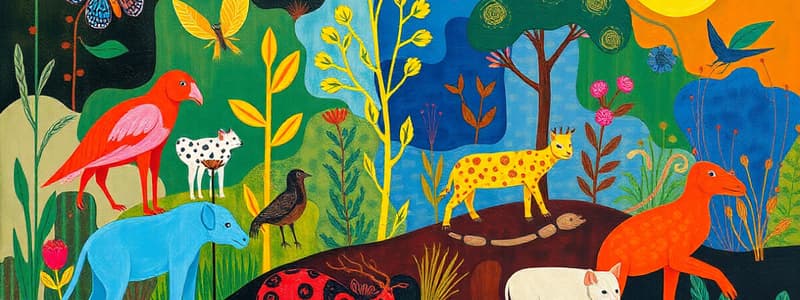Podcast
Questions and Answers
What does the term biological diversity primarily refer to?
What does the term biological diversity primarily refer to?
- The genetic variation within a single species
- The variety of different species within a specific ecosystem (correct)
- The range of ecosystems in a geographical area
- The number of individuals in a population
Which of the following correctly distinguishes the types of adaptations in organisms?
Which of the following correctly distinguishes the types of adaptations in organisms?
- Behavioral adaptations occur only in animals.
- Structural adaptations are physical traits that improve survival. (correct)
- Structural adaptations involve behavior changes.
- Behavioral adaptations are physical features.
What is a major characteristic that defines a species?
What is a major characteristic that defines a species?
- Morphological similarities to other species
- Ability to adapt to all environments
- Presence of migratory behavior
- Reproductive isolation from other groups (correct)
What is resource partitioning?
What is resource partitioning?
Which of the following describes an advantage of asexual reproduction?
Which of the following describes an advantage of asexual reproduction?
In what way do generalists differ from specialists regarding their niches?
In what way do generalists differ from specialists regarding their niches?
What is the primary role of natural selection in evolution?
What is the primary role of natural selection in evolution?
What occurs during binary fission in microorganisms?
What occurs during binary fission in microorganisms?
Study Notes
Topic 1 - Biological Diversity and Survival
- Biological diversity (biodiversity) refers to the variety of life forms on Earth, encompassing different species, ecosystems, and genetic variations.
- Abiotic factors are non-living components (e.g., climate, soil), while biotic factors are living organisms (e.g., plants, animals) affecting biodiversity.
- Structural adaptations are physical features enhancing survival (e.g., camouflage in chameleons), whereas behavioral adaptations are actions organisms take to survive (e.g., migration in birds).
- Variation within a species enhances adaptability and resilience to environmental changes, promoting evolutionary success.
- Species arrangement hierarchy:
- Individual: A single organism.
- Population: Group of individuals of the same species in a specific area.
- Community: Interacting populations of different species in a given area.
- Ecosystem: Community plus abiotic factors, functioning as a unit.
- Variation within a species pertains to differences among individuals, while variation between species refers to the diversity that exists among different species.
- The 7-step Classification System includes:
- Domain
- Kingdom
- Phylum
- Class
- Order
- Family
- Genus
- Species
- Unique characteristics of a species include specific traits, reproductive isolation, and genetic makeup.
- Speciation is the evolutionary process through which new biological species arise.
Topic 2 - Habitat and Lifestyle
- An organism's niche encompasses its role in the ecosystem, including habitat, resource use, and interactions with other species.
- Resource partitioning is the process where different species utilize different resources to reduce competition.
- In spruce trees, resource partitioning allows multiple warbler species to coexist at various tree levels, protecting them from competition. A lightning strike to the top would negatively affect higher-nesting warblers.
- Northern Canada's environment leads to fewer species and larger populations ("broad niche"), while Central and South America's varied environments support high diversity and smaller populations ("narrow niche").
- Specialists adapt to specific environments and resources, while generalists thrive in a broader range of conditions and resources.
- Types of symbiotic relationships:
- Commensalism: One species benefits, the other is unaffected (e.g., barnacles on whales).
- Mutualism: Both species benefit (e.g., bees pollinating flowers).
- Parasitism: One species benefits at the expense of the other (e.g., ticks on mammals).
- Interspecies competition: Different species compete for the same resources (e.g., plants competing for sunlight).
- Natural selection is the process whereby organisms better adapted to their environment tend to survive and produce more offspring. An example is the coloration of peppered moths shifting due to industrial pollution.
Topic 3 - Passing It On
- Asexual reproduction methods include:
- Binary Fission: Single organism divides into two (e.g., bacteria).
- Spore Production: Organism produces spores that can grow into new individuals (e.g., fungi).
- Cuttings: New plants grow from cut sections of the parent (e.g., sugar cane).
- Budding: New organism develops from a bud on the parent (e.g., yeast).
- Vegetative Reproduction: New individuals form from parts of the parent plant (e.g., runners in strawberries).
- Zoospore: A motile spore allowing for reproduction in aquatic environments (e.g., some algae).
- Sexual reproduction in plants involves pollen fertilizing ovules. Flower parts include stigma, style, ovary (female) and anther, filament (male).
- Sexual reproduction in animals involves the fusion of male and female gametes, resulting in offspring with genetic contributions from both parents.
- Conjugation in bacteria is a process where two bacteria transfer genetic material through direct contact, enhancing genetic diversity.
- Advantages of sexual reproduction include genetic diversity and adaptability, while disadvantages include requiring two parents and longer developmental time. Asexual reproduction offers rapid population increase and is more energy-efficient, but lacks genetic variability.
Studying That Suits You
Use AI to generate personalized quizzes and flashcards to suit your learning preferences.
Related Documents
Description
This quiz reviews essential concepts from Unit A, Topic 1-3, focusing on biological diversity, adaptations, and the arrangement of species. Test your understanding of the differences between abiotic and biotic factors, and explore individual, population, community, and ecosystem levels. Get ready to deepen your knowledge of the foundations of ecology.




